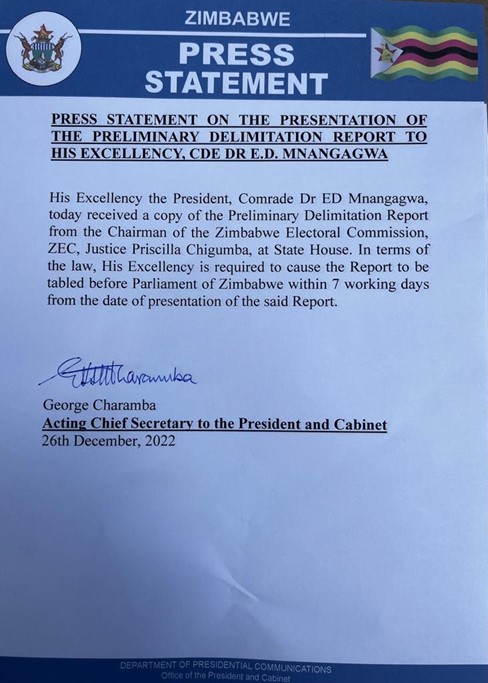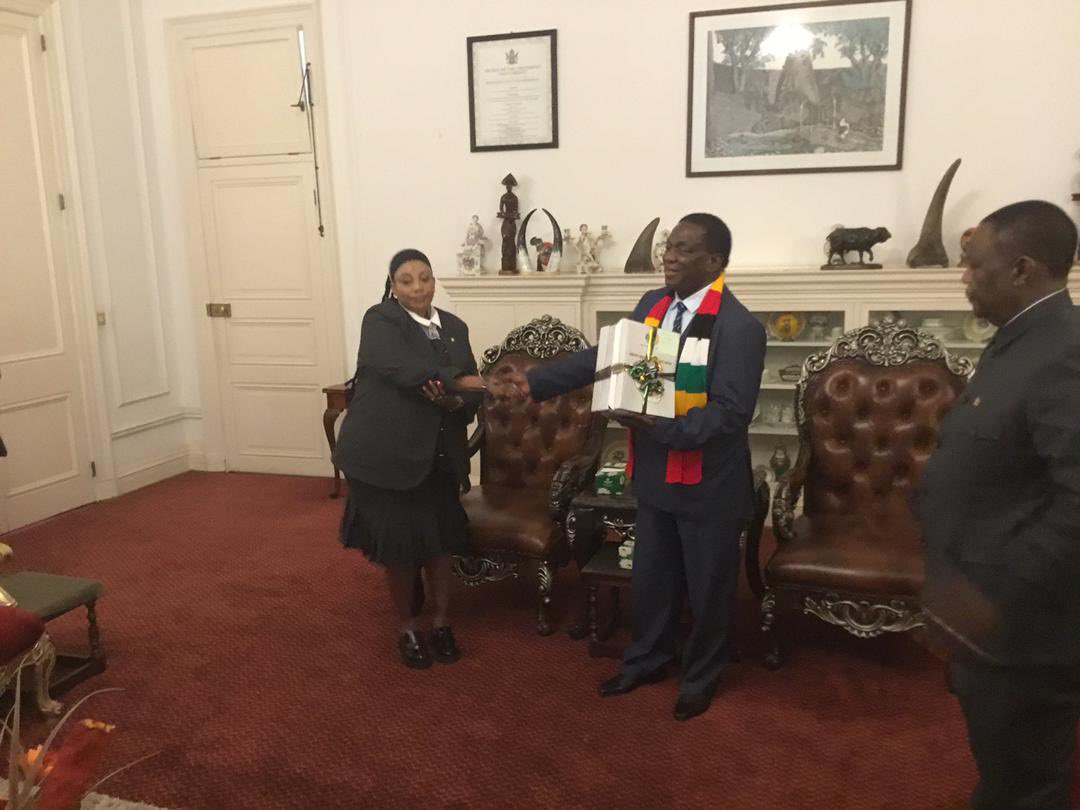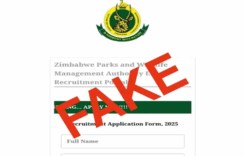Claim: President Emmerson Mnangagwa broke his annual vacation, just days into the holiday for an official ceremony to receive a Preliminary Delimitation Report from the Zimbabwe Electoral Commission (ZEC), but Parliament as a separate arm of the State is not obliged to convene urgently to consider the Report, according to interpretations on some social media platforms.
Is this True of False?
False.
Under Section 110 of the current Constitution, the President’s powers include those to summon, adjourn and dissolve Parliament, and the power to appoint a limited number of members of Parliament.
Therefore Zimbabwe’s Executive Presidential system allows the President to order Parliament into conducting “extraordinary” sittings to consider Special business matters — outside the schedules set by Parliament.
So although Parliament adjourned Sitting in mid December to January 24, 2023, it will be called to meet earlier to debate the Preliminary Delimitation Report, with new proposals of boundaries of parliamentary constituencies and local government wards for general elections due by August 2023. After receiving the Delimitation Report, the law requires the President to cause the tabling of the Report to Parliament within seven working days, after which Parliament has 14 sitting days during which to study the Report before submitting its opinion to the President
The President can refer and recommend further items to ZEC for consideration before the final adoption of the Delimitation Report

Delimitation
Delimitation is the process of dividing the country into constituencies and wards for the purposes of elections of persons to constituency seats in the National Assembly and of councillors to local authorities. The process is carried out in terms of sections 160 and 161 of the new Constitution
Section 160: Number of Constituencies and Wards
- For the purpose of electing Members of Parliament, the Zimbabwe Electoral Commission must divide Zimbabwe into two hundred and ten constituencies.
- For the purpose of elections to local authorities, the Zimbabwe Electoral Commissionmust divide local authority areas into wards according to the number of members to be electedto the local authorities concerned.
Section 161: Delimitation of Electoral Boundaries
- Once every ten years, on a date or within a period fixed by the Commission so as to fall as soon as possible after a population census, the Zimbabwe Electoral Commission mustconduct a delimitation of the electoral boundaries into which Zimbabwe is to be divided.
- If a delimitation of electoral boundaries is completed less than six months before pollingday in a general election, the boundaries so delimited do not apply to that election, and insteadthe boundaries that existed immediately before the delimitation are applicable.
- The boundaries of constituencies must be such that, so far as possible, at the time ofdelimitation equal numbers of voters are registered in each constituency within Zimbabwe.
- The boundaries of wards must be such that, so far as possible, at the time of delimitationequal numbers of voters are registered in each ward of the local authority concerned.
- In delimiting-
(a) the boundaries of wards, the Zimbabwe Electoral Commission must ensure that noward is divided between two or more local authority areas;
(b) the boundaries of constituencies, the Zimbabwe Electoral Commission must ensurethat no ward is divided between two or more constituencies
- In dividing Zimbabwe into wards and constituencies, the Zimbabwe Electoral Commission must, in respect of any area, give due consideration to –
(a) its physical features;
(b) the means of communication within the area;
(c) the geographical distribution of registered voters;
(d) any community of interest as between registered voters;
(e) in the case of any delimitation after the first delimitation, existing electoral boundaries; and
(f) its population;
- and to give effect to these considerations, the Commission may depart from the requirement thatconstituencies and wards must have equal numbers of voters, but no constituency or ward of the local authority concerned may have more than twenty per cent more or fewer registered voters than the other such constituencies or wards.
- After delimiting wards and constituencies, the Zimbabwe Electoral Commission mustsubmit to the President a preliminary report containing
(a) a list of the wards and constituencies, with the names assigned to each and adescription of their boundaries;
(b) a map or maps showing the wards and constituencies; and
(c) any further information or particulars which the Commission considers necessary; and the President must cause the preliminary delimitation report to be laid before Parliamentwithin seven days.
- Within fourteen days after a preliminary delimitation report has been laid beforeParliament-
(a) the President may refer the report back to the Zimbabwe Electoral Commission forfurther consideration of any matter or issue;
(b) either House may resolve that the report should be referred back to the ZimbabweElectoral Commission for further consideration of any matter or issue, and in thatevent the President must refer the report back to the Commission for that furtherconsideration.
- Where a preliminary delimitation report has been referred back to it under subsection(8), the Zimbabwe Electoral Commission must give further consideration to the matter or issueconcerned, but the Commission’s decision on it is final.
- As soon as possible after complying with subsections (7) and (9), the Zimbabwe Electoral Commission must submit a final delimitation report to the President.
- Within fourteen days after receiving the Zimbabwe Electoral Commission’s finalreport, the President must publish a proclamation in the Gazette declaring the names and boundaries of the wards and constituencies as finally determined by the Commission.
- If there is a discrepancy between the description of the boundaries of any ward orconstituency and the map or maps prepared by the Zimbabwe Electoral Commission, the description prevails.
- Note: For the first election after the new Constitution comes into operation the new Constitution has a transitional provision that provides “the boundaries of provinces, constituencies and wards as they were immediately before the publication day [of the Constitution] apply for the purposes of the first election.”
Sources:
Zimbabwe Constitution, Section 160 and 161, Zimbabwe Constitution, Section 110,
Zimbabwe Government Press Statement, by George Charamba, Acting Chief Secretary to the President and Cabinet,
Zimbabwe Electoral Commission (ZEC), www.zec.org.zw
Veritas – https://www.veritaszim.net/
Do you want to use our content? Click Here












